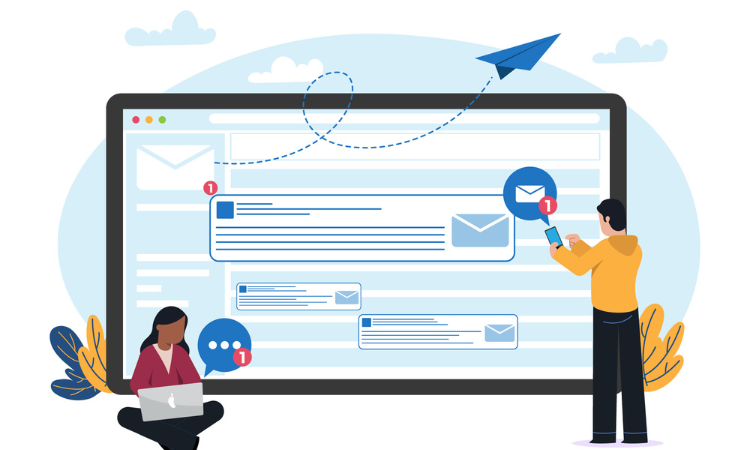In my interactions with businesses globally spanning over more than ten years, one thing has always remained true—every business wants to measure Net Promoter Score. And rightly so. NPS isn’t just another CX metric; it’s a growth engine that helps businesses track loyalty, predict churn, and drive long-term success.
But here’s the challenge: measuring NPS effectively—and turning it into real growth—requires the right tools. The best NPS Survey Tools go beyond just measuring feedback; they transform raw customer feedback into actionable strategies. And now in 2025, with AI-driven insights, real-time trend analysis, and automated workflows, these tools help businesses spot at-risk customers, identify brand advocates, and enhance customer experiences—ultimately driving retention and growth like never before.
That’s why we’ve created this detailed guide—to help you find the best NPS tool based on your business needs. Whether you need a comprehensive solution, an industry-specific NPS Survey tool, or a simple platform to get started, we’ve outlined the top options to help you measure, analyze, and act on customer feedback effectively.
We’ve also updated our NPS Guide to reflect how NPS continues to evolve as a growth strategy, with insights on how to apply it effectively in real-world scenarios.
Ready to find the perfect NPS tool for your business? Let’s dive in. 🚀
TL;DR
- NPS is more than a metric — it’s a growth engine for measuring loyalty, predicting churn, and driving retention.
- Choosing the right NPS Survey software is critical to turn feedback into action, not just collect scores.
- This guide covers the best NPS survey tools in 2025 — categorized by use case: all-in-one platforms, lightweight tools, industry-specific solutions, and more.
- We evaluated NPS tools based on setup, feedback collection, AI capabilities, reporting, integrations, and pricing.
- Zonka Feedback stands out as an AI-powered, omnichannel NPS Survey software that helps you deploy NPS surveys, uncover insights, and close the loop with ease. Interested in learning more? Book a Demo.
- Whether you're just starting or scaling your NPS program, this guide will help you find a tool that fits your business and customer experience goals.
Gauge Customer Loyalty by Deploying NPS Surveys Effortlessly
NPS helps you understand what drives customer loyalty and act on real-time insights to drive business growth.

What is Net Promoter Score and how does it work?
If you could ask your customers just one question to measure their loyalty, predict your company’s growth, and compare your brand’s performance against competitors—all in seconds—wouldn’t you?
That’s exactly what Net Promoter Score does.
At its core, NPS measures how likely your customers are to recommend your brand to others. But over the years, it has evolved from a simple feedback metric into one of the most powerful benchmarking tools in customer experience (CX). Businesses worldwide use it to track loyalty, identify churn risks, and turn passive buyers into lifelong advocates.
How does NPS work?
It all starts with a single, game-changing question: "On a scale of 0-10, how likely are you to recommend our company/product/service to a friend or colleague?"
The NPS Question is often followed by an open-ended question: "What is the primary reason for your score?"
This second question provides the why behind the score, helping businesses understand customer emotions and sentiment and take meaningful action.
Based on their responses, customers fall into three categories:
-
Promoters (9-10) – NPS Promoters are your brand champions. They love your product, stay loyal, and actively recommend your business, fueling organic growth.
-
Passives (7-8) – NPS Passives are one who are satisfied but not enthusiastic. They won’t speak negatively about your brand, but they won’t promote it either.
-
Detractors (0-6) – Detractors are the unhappy customers who are likely to churn and even discourage others from choosing your business.
Your Net Promoter Score is calculated by subtracting the percentage of Detractors from the percentage of Promoters. Above 0 is considered a good NPS Score, which means that you have more promoters than detractors. And of course, moving towards +100 means you're doing better.
But here’s the real takeaway—the number itself isn’t where the magic lies. It’s what you do with these insights that makes NPS invaluable. Like holding your promoters close, not letting your passives slip away and acting swiftly with detractors to not lose them. And that's where NPS Software come in.
Why you need NPS Software?
While 83% of companies say they track NPS in some form, only 24% take consistent action based on the feedback they collect. That gap is where most businesses fall short—and where the right NPS software can make all the difference. Because Measuring NPS is one thing—using it to actually drive growth is another.
NPS survey tools bridges the gap between collecting scores and turning insights into action with effective NPS surveys. These tools don't just tell you who your Promoters and Detractors are—but help you understand why they feel that way and what you can do about it - converting your quantitative data into actionable feedback. From triggering surveys at key moments in the customer journey to analyzing sentiment, spotting churn risks, and streamlining follow-ups, NPS tools turn raw feedback into real opportunities for growth.
Think of it this way: What’s the value of knowing a customer is unhappy if you don’t have a system in place to win them back? Or recognizing a loyal Promoter but missing the chance to turn them into a vocal brand advocate? NPS survey softwares ensures you never miss those moments.
In this section, we’ll dive into:
-
What NPS survey tool actually does
-
The must-have features to look for
-
How we evaluated the best NPS tools to help you find the perfect fit
What is an NPS Software?
NPS Survey Software is designed to help businesses collect, analyze, and act on Net Promoter Score feedback. It automates the entire process—from triggering surveys at the right moments in the customer journey to analyzing responses and helping you close the loop with customers.
But modern Net Promoter Score tools don't stop at just measuring loyalty. They help you:
-
Trigger surveys based on specific customer actions (like after a purchase or support interaction).
-
Analyze open-ended responses with AI-powered sentiment analysis.
-
Identify trends and patterns over time.
-
Engage directly with Detractors and amplify Promoters to turn them into brand advocates.
In short, NPS Survey platforms transforms NPS from a simple score into an actionable growth strategy.
Most NPS platforms come with standard features to help businesses get started, like:
-
Survey Creation & Distribution – Build and send customized NPS Surveys with branding and follow-up questions, distributed across multiple channels.
-
Basic Reporting – View your overall Net Promoter Score and a breakdown of Promoters, Passives, and Detractors.
-
Follow-Up Workflows – Automate simple follow-ups based on customer responses and scores.
-
Response Management – A dashboard to view and manage individual responses, sorted by score or sentiment.
These features are great for getting started—but if you want to leverage NPS as a growth engine, you’ll need a tool that offers more advanced capabilities.
What features should you look for in an NPS tool?
If you’re serious about improving loyalty and driving growth, look for NPS software that goes beyond the basics. Here are the must-have features that make a difference:
-
Advanced Survey Triggers – Send surveys based on specific events in the customer journey (e.g., post-onboarding, after purchase, or post-support).
-
AI-Powered Insights & Sentiment Analysis – Understand the “why” behind scores with tools that analyze open-ended question responses and detect sentiment.
-
Real-Time Alerts & Notifications – Get immediate alerts when a Detractor leaves feedback, so you can act before they churn.
-
Engagement Workflows – Close the loop with built-in workflows that help you engage Detractors, thank Promoters, and convert Passives.
-
Multi-Channel Feedback Collection – Reach customers via email, SMS, in-app surveys, website widgets, and more.
-
Customizable Dashboards & Reporting – Gain clear, actionable insights with reports that track trends over time.
-
Seamless Integrations – Ensure your NPS tool integrates with your existing tech stack, like CRMs (Salesforce, HubSpot, MS Dynamics and the like), helpdesks (Zendesk, Freshdesk, Intercom), or marketing platforms.
How we compiled this list of the Best NPS Softwares
With so many NPS tools out there, we know how tough it can be to find the one that actually fits your needs. That’s why we did the heavy lifting for you.
We evaluated each tool based on real-world usability, features, and value, focusing on the factors that truly impact your NPS program. These include:
-
Setup Process – How easy is it to get started? We assessed onboarding, customization options, and learning curves.
-
Collection Capabilities – We looked at multi-channel survey distribution and whether tools offer advanced triggers.
-
AI Features & Reporting – We evaluated how well each platform analyzes responses, detects sentiment, and delivers actionable insights.
-
Engagement & Follow-Up – Does the tool help you respond to feedback effectively? We focused on how well each platform supports customer engagement.
-
Integration Capabilities – We prioritized tools that integrate seamlessly with CRMs, helpdesks, and marketing platforms.
-
Pricing & Value – Finally, we compared pricing plans to find tools that offer the best balance between features, scalability, and affordability.
With this thorough analysis, we’ve curated a list of the best NPS software to help you measure, analyze, and act on feedback—no matter your industry or business size.
Ready to find the perfect NPS tool for your business? Let’s explore the top options! 🚀
A Quick Overview of the Top NPS Tools
Here is a table of the best NPS survey tools highlighting G2 rating scores, and what they are best for:
|
NPS Software Tools |
Best For |
Key Features |
Customer Support |
G2 Rating |
Price |
|
Zonka Feedback |
Businesses of all sizes—from startups to Fortune 500 companies |
Customizable survey creation, AI analytics, real-time reporting |
24x7 via email, live chat, phone, CSMs, help center |
4.7 |
$49/month |
|
Qualtrics |
Large organizations needing flexible and powerful NPS platform |
Advanced analytics, customer feedback management |
Email, chat, and phone |
4.4 |
Not Available |
|
CustomerGauge |
B2B companies connecting feedback with revenue data |
Account-based NPS, customer retention analytics |
Email and phone |
4.7 |
Not Available |
|
Delighted |
Small businesses and e-commerce seeking simple surveys |
Pre-built templates, automation, simple setup |
Email, documentation |
4.7 |
$17/month |
|
GetFeedback |
Salesforce users seeking real-time feedback in CRM |
Pre-built templates, mobile-optimized, advanced targeting |
Help center, docs, 24/7 for enterprise |
4.6 |
Not Available |
|
Survicate |
Digital businesses and SaaS startups |
Web pop-ups, email, in-app, AI text analytics |
Email, documentation |
4.5 |
$99/month |
|
Refiner |
SaaS companies focused on in-app NPS feedback |
Behavior-based triggers, advanced segmentation |
Email, documentation |
4.8 |
$99/month |
|
AskNicely |
Frontline and customer-centric teams for daily feedback |
Feedback automation, CRM integration, team leaderboards |
Email, chat, CSMs |
4.7 |
Not Available |
|
Gainsight |
Medium to large enterprises for customer success programs |
Health scoring, journey orchestration, AI analytics |
Email, documentation, onboarding support |
4.4 |
Custom Pricing |
|
Pendo |
Product-led SaaS companies collecting in-app NPS |
Segment-based delivery, in-app NPS, behavior-based triggers |
Email, help center |
4.6 |
Free for up to 500 MAUs |
|
Typeform |
Design-focused teams creating conversational forms |
Interactive design, multi-channel distribution |
Email, chat, help center |
4.5 |
$25/month |
1. Zonka Feedback: Omni-Channel AI-Driven NPS Survey Tool
Zonka Feedback is a powerful omnichannel NPS feedback platform that helps businesses collect, analyze, and take action across every touchpoint. It stands out for its ease of use, deep customization, and AI-driven insights, making it an excellent choice for businesses seeking an all-in-one feedback solution that’s both robust and user-friendly with all NPS Software features.
Zonka Feedback has consistently been recognized in G2 Reports, earning badges for Easiest to Set Up, Easiest to Use, Best Support, Fastest Implementation, Best Estimated ROI, and Highest User Adoption.
Setup Process: Get started quickly without coding
Zonka Feedback offers a quick and intuitive setup process designed for users with no coding skills. Whether you’re using AI-assisted survey creation, expert templates, or starting from scratch, you can set-up NPS program and launch NPS surveys within minutes.
-
Pre-built NPS templates that are fully customizable. You can create surveys, add multiple question types, including choices, dropdowns, open-ended comment boxes, and combine NPS with CSAT (Customer Satisfaction Score) and CES (Customer Effort Score) for measuring customer experience.
-
Logic-based follow-up questions that personalize surveys based on responses. Promoters, passives, and detractors receive tailored follow-up questions to dive deeper into the reasons behind their scores based on survey logic.
-
Design flexibility that allows you to customize surveys to match your brand. Change colors, logos, backgrounds, and themes to create a consistent brand experience.
-
Multilingual surveys with AI-powered translations. Customers can respond in their preferred language, helping you reach a global audience and get more responses.
-
Custom attributes and hidden variables that let you personalize surveys. Pass information like user IDs or purchase history into the survey for deeper analysis during reporting.
These features make it simple to create surveys that align with your brand and customer journey while capturing detailed insights.
Collection Capabilities: Reach customers across every touchpoint
Zonka Feedback excels in omnichannel survey distribution, helping businesses reach customers wherever they are in their journey. Its diverse distribution options maximize responses and ensure no touchpoint is missed.
-
Website surveys using feedback buttons, popups, slide-ups, inline embeds, and article embeds. Collect NPS on website along with contextual feedback on web pages without disrupting the user experience.
-
In-app, contextual surveys using mobile SDKs compatible with iOS, Android, and React Native. Trigger surveys based on user actions, like completing a purchase or hitting a product milestone.
-
Offline kiosks for on-premises feedback and field surveys. With offline surveys, collect feedback in stores, events, or field locations even without internet access, with data syncing automatically when back online.
-
Email surveys with NPS question embedded directly in the email body or included in email signatures. Pre-designed templates are available and can be downloaded for use across different platforms.
-
SMS and WhatsApp surveys sent via Zonka Feedback’s gateways or your own. These channels are ideal for reaching customers on the go and can be used for one-time surveys or recurring campaigns.
-
Custom triggers for automating survey distribution. Trigger surveys based on customer actions such as purchases, support interactions, or app usage. Set up recurring and scheduled surveys for emails, SMS, and WhatsApp to continuously gather feedback. Also, set up survey throttling to ensure you never oversurvey your customers.
This broad range of collection methods ensures you get comprehensive feedback coverage across the customer journey.
AI Features & Reporting: Turn feedback into actionable insights
Zonka Feedback’s AI-powered reporting goes beyond basic NPS rating, helping businesses uncover meaningful customer insights.
-
Snapshot reports provide a real-time overview of NPS performance, highlighting the distribution of promoters, passives, and detractors.
-
Trend reports track NPS over time, to see how happy customers are, allowing businesses to spot shifts in scores across specific periods and compare performance month-over-month or year-over-year. This is especially key in understanding business performance over time.
-
Location-based CX reporting helps businesses compare NPS scores across different branches, stores, or regions. It identifies top-performing locations and highlights underperforming ones, making it easier to implement targeted improvements. For example, with location-based CX, a retail chain can see which stores are excelling and which need support.
-
Agent-based CX reporting offers detailed insights into team and individual performance. Businesses can track scores at the agent level, understand how specific interactions impact customer feedback, and identify opportunities for coaching or recognition. For example, with agent-based CX reports in a SaaS company, support managers can track which agents resolve tickets efficiently and which need training to improve customer satisfaction.
-
Word and sentiment analysis uses AI to break down open-ended comments, surfacing key themes and categorizing responses as positive, negative, or neutral. This helps businesses quickly grasp common pain points and areas of satisfaction.
-
Urgency detection and intent analysis flag critical feedback that requires immediate attention. The system highlights at-risk customers, detects emotional cues, and identifies comments that suggest potential churn or upsell opportunities.
-
Customizable and drill-down reporting enables businesses to filter and segment data by location, agent, product, or custom attributes, allowing for a deeper understanding of specific trends.
With these reporting capabilities and valuable insights, Zonka Feedback helps businesses optimize experiences across every location and team, turning insights into actionable strategies.
Closing the Feedback Loop: From data to action
Zonka Feedback makes it easy to close the feedback loop, ensuring businesses don’t just collect feedback but actively respond to it. The platform’s built-in workflows and alerts simplify the process of following up with customers.
-
Customizable workflows that automate follow-ups based on NPS scores. Detractors can receive apology emails or support offers, while loyal customers can be encouraged to leave public reviews or referrals.
-
Real-time team alerts that notify the right people when specific triggers occur. For example, a low NPS score can instantly alert the customer success team to follow up.
-
Task creation that allows businesses to assign follow-up actions to team members. Tasks can be created directly within Zonka Feedback to ensure accountability and proper handling of feedback.
-
Internal notes that let team members collaborate on responses, adding context to feedback and streamlining communication.
-
Direct email responses that can be sent to customers from within the platform. Businesses can thank customers for positive feedback or address issues raised in negative responses. Follow-up surveys can also be sent to measure if issues were resolved successfully.
These features make it simple for businesses to act on feedback, improve customer satisfaction, and turn negative experiences into positive outcomes.
Integration Capabilities: Seamlessly connect your tech stack
Zonka Feedback integrates with a wide range of tools, enabling businesses to automate workflows, trigger surveys based on customer actions, and sync feedback data across platforms.
-
CRMs like Salesforce, HubSpot, Microsoft Dynamics, Active Campaign and Pipedrive. Trigger surveys based on CRM events such as deal closures or customer milestones, and sync responses back into the CRM for a complete customer profile.
-
Helpdesk platforms including Zendesk, Intercom, Freshdesk, and Front. Send post-support surveys and log feedback directly into support tickets, making it easy to measure customer satisfaction after each interaction.
-
Marketing tools like Mailchimp, ActiveCampaign, and Constant Contact. Incorporate NPS surveys into marketing workflows to take feedback during campaigns and customer engagement efforts.
-
APIs and webhooks for custom integrations. Businesses can build custom workflows and connect Zonka Feedback with any tool in their stack.
-
Automation platforms like Zapier, Make and Integromat. These platforms help businesses create complex workflows without custom development, connecting Zonka Feedback to thousands of other applications.
These integrations ensure that feedback flows seamlessly across your organization, enabling every team to access the insights they need.
Pricing: Flexible plans for every business size
Zonka Feedback offers flexible pricing plans designed to fit businesses of all sizes. Pricing is based on the number of responses collected and the channels used, allowing businesses to scale as they grow.
-
Plans start at $49 per month, making it accessible for small businesses while offering scalability and advanced features for larger enterprises.
-
Each plan includes access to omnichannel distribution, AI-powered reporting, and integrations with popular tools.
-
A free trial is available, allowing businesses to explore Zonka Feedback’s features and capabilities before committing.
Given its extensive feature set, ease of use, and powerful AI insights, Zonka Feedback offers strong value for money and a high return on investment.
Ideal for
Zonka Feedback is ideal for businesses that want a comprehensive, omnichannel NPS tool with powerful AI-driven insights, extensive customization, and seamless integrations. It’s perfect for multi-location businesses, SaaS companies, healthcare providers, retail chains, and any organization that values feedback and wants to take meaningful action to improve customer experiences.
Boost Customer Loyalty & Retention by Tracking NPS in Real-Time
Use instant feedback to take action to improve customer experience and increase customer loyalty and satisfaction.

2. Qualtrics: Enterprise NPS Survey Tool
Qualtrics is an enterprise-grade NPS platform tailored for large organizations that need scalable and customizable feedback solutions. It’s widely recognized for its powerful analytics and flexibility but is often noted for its complex setup process and higher pricing. Despite these considerations, this enterprise survey software remains a top choice for businesses seeking deep insights and advanced customer experience management.
 Setup Process
Setup Process
Qualtrics offers a highly customizable but complex setup. The implementation process can be time-consuming and often requires dedicated onboarding support to fully utilize its advanced capabilities. While the flexibility is a strength, businesses should be prepared for a longer setup period compared to more lightweight NPS tools.
Collection Capabilities
Qualtrics supports multi-channel feedback collection, ensuring businesses can gather NPS data across all customer touchpoints:
-
Web and email surveys
-
Mobile and SMS surveys
-
In-app surveys and offline data collection
-
Social media listening for organic feedback
Its ability to unify data from diverse channels is a significant strength, offering a complete view of customer sentiment.
AI Features & Reporting
Qualtrics provides advanced AI-driven analytics that help businesses extract deep insights from feedback:
-
Predictive analytics to forecast customer trends and behaviors
-
Root cause analysis to identify underlying issues affecting NPS
-
Sentiment analysis to understand customer emotions in open-text responses
-
Customer journey mapping to track how interactions across touchpoints impact the overall experience
-
Segmented reporting to analyze NPS by location, region, product line, or customer segment
While these features are robust, some users report a steeper learning curve when navigating complex reporting dashboards.
Closing the Feedback Loop
Qualtrics simplifies the process of closing the feedback loop with:
-
Automated alerts for low NPS scores
-
Case management and ticketing to route feedback to appropriate teams
-
Follow-up workflows for timely customer engagement
-
Recovery tracking to measure improvements post-intervention
These tools help businesses manage feedback at scale, though configuring advanced workflows can be complex initially.
Integration Capabilities
Qualtrics integrates seamlessly with major basic as well as enterprise tools, enabling smooth data flow across systems. Some notable integrations include:
-
CRMs: Salesforce, Microsoft Dynamics
-
ERP Systems: SAP, Oracle
-
Marketing Platforms: Adobe, HubSpot
-
Collaboration Tools: Slack, Microsoft Teams
The platform also offers open APIs and webhooks for custom integrations, though setting up more complex integrations may require technical expertise.
Pricing
Qualtrics uses a custom pricing model tailored to business size and feature requirements. It is generally considered expensive, reflecting its extensive capabilities and focus on large enterprises.
Ideal for
Qualtrics is ideal for large enterprises and global organizations that require a comprehensive, scalable NPS solution with advanced analytics and deep customization. It’s best suited for businesses managing complex customer experience programs that have the resources and budget to leverage a premium platform.
3. CustomerGauge: NPS Account Experience
CustomerGauge is a specialized NPS software built for B2B companies with a strong emphasis on account-level feedback management. Its core strength lies in directly linking NPS scores to revenue, helping businesses understand how customer sentiment affects growth, retention, and churn. Designed specifically for B2B workflows, it excels in managing complex client relationships and offers insights into account health and churn risks. While CustomerGauge shines in account-based NPS tracking, it has limitations in digital surveys and doesn’t support other metrics like CSAT or CES, making it most suitable for businesses focused purely on NPS.
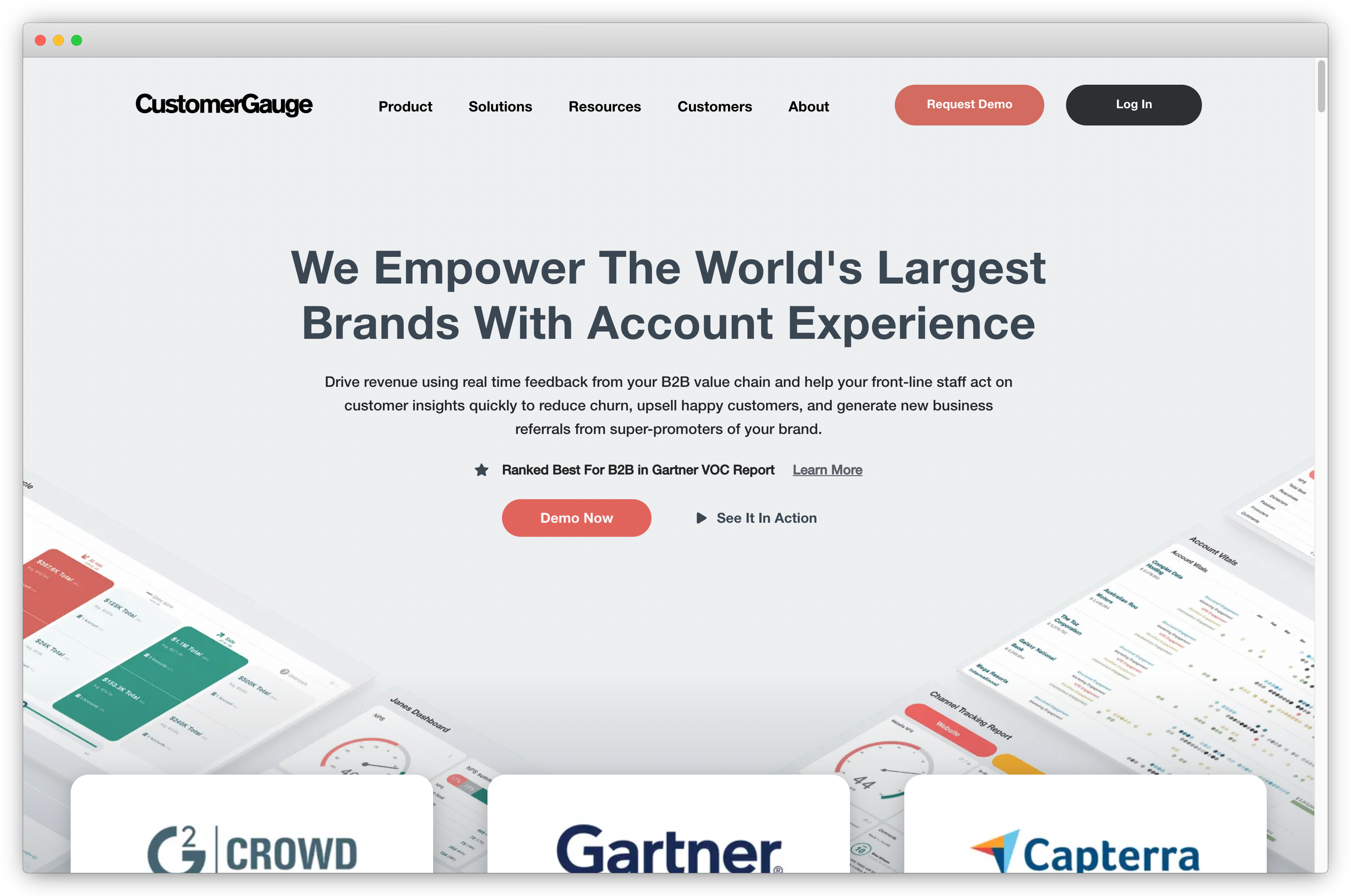
Setup Process
CustomerGauge offers a B2B-focused setup, tailored to manage feedback at the account level. The onboarding process is streamlined yet often benefits from expert assistance to configure complex account structures and workflows. The setup is optimized for companies prioritizing account health and revenue-driven NPS strategies.
Collection Capabilities
CustomerGauge focuses on relationship-driven feedback collection, helping businesses engage with key decision-makers and stakeholders within client organizations:
-
Email surveys sent directly to contacts within accounts
-
In-app surveys for SaaS platforms, enabling timely feedback during product use
-
Phone-based surveys for high-touch client interactions
The platform prioritizes direct and personalized feedback channels that align with B2B relationship management. Customer Gauge is more focused on Relationship NPS than Transactional NPS.
AI Features & Reporting
CustomerGauge offers AI-driven feedback insights and analytics centered around account health and revenue impact:
-
Account health scoring to evaluate satisfaction and engagement at the account level
-
Churn prediction models that flag accounts at risk based on NPS trends and engagement metrics
-
Revenue linkage to tie NPS data directly to account value, helping teams prioritize high-revenue clients
-
Segmented reporting by account, industry, and region to uncover trends and patterns across different segments
The reporting focuses on providing a clear connection between customer sentiment and revenue, helping businesses make data-driven decisions.
Closing the Feedback Loop
CustomerGauge simplifies account-level feedback management with tools designed to close the loop effectively:
-
Automated alerts for low NPS scores from key accounts
-
Task assignment workflows to ensure follow-ups are handled by the right account managers
-
Revenue-based prioritization so high-value clients receive attention first
-
Churn recovery tracking to monitor the impact of follow-up actions on customer sentiment
These workflows help businesses retain and grow accounts by ensuring timely and targeted responses.
Integration Capabilities
CustomerGauge integrates seamlessly with leading B2B platforms, enabling businesses to sync feedback data with existing workflows:
-
CRMs: Salesforce, HubSpot for syncing NPS data with account profiles
-
Marketing Automation: Marketo, Pardot for targeted customer outreach
-
APIs and Webhooks for custom integrations to fit unique business needs
These integrations allow businesses to connect NPS insights directly to their sales, marketing, and customer success efforts.
Pricing
CustomerGauge follows a custom pricing model, based on the number of accounts, users, and specific feature requirements. Pricing is tailored to suit mid-to-large B2B organizations focused on account-level NPS management.
Ideal for
CustomerGauge is ideal NPS Survey tool for B2B companies, particularly in industries like CPG, manufacturing, and SaaS, that want to manage NPS at the account level and directly connect customer feedback to revenue metrics. It’s a strong fit for businesses focused on customer retention, account growth, and churn prevention.
4. Delighted: Simple, Auto-Pilot Surveys
Delighted offers a streamlined approach to NPS surveys, making it ideal for businesses seeking a simple, automated solution. Its easy setup and pre-built templates allow businesses to schedule surveys, collect responses, and analyze feedback with minimal manual effort. Delighted is great for companies that want to focus on measuring customer loyalty and getting real-time feedback without spending too much time on setup or management. While it excels in simplicity, it comes with some limitations, particularly around survey customization, flexibility and closing the feedback loop.

Setup Process
Delighted is known for its fast and intuitive setup, allowing businesses to launch surveys quickly using pre-built templates and automation features. The platform follows a standard survey flow—starting with a chosen metric, followed by a follow-up question and a thank-you screen. While this simplicity speeds up the process, it limits customization. Businesses cannot measure two metrics within the same survey, and design options are minimal. It’s best suited for companies that prefer simple surveys without complex branching or advanced customization.
Collection Capabilities
Delighted supports automated survey distribution across several key channels, helping businesses get feedback consistently:
-
Email surveys with embedded NPS or CSAT questions
-
SMS surveys for reaching customers on the go
-
Web surveys embedded on websites or shown as pop-ups
-
In-app surveys for gathering feedback directly within products
The platform’s automation ensures surveys go out on schedule with minimal manual input.
AI Features & Reporting
Delighted provides basic reporting features focused on simplicity and clarity:
-
Simple NPS reports dashboards to track CX scores
-
Response filtering by date, channel, and customer segments
-
Basic analysis to gauge positive or negative trends
While its reporting is easy to navigate, it lacks advanced analytics or AI-driven insights, making it better suited for businesses that need high-level overviews rather than in-depth data analysis.
Closing the Feedback Loop
Delighted offers basic tools for following up on feedback but doesn’t provide extensive features for closing the loop:
-
Simple alerts for low NPS or CSAT scores
-
Basic follow-up workflows to reach out to dissatisfied customers
-
Manual tracking of follow-ups, with limited automation
The focus is more on survey distribution and collection rather than detailed feedback management.
Integrations
Delighted integrates with popular platforms, helping businesses sync feedback data across their tech stack. Some key integrations include:
-
Shopify for e-commerce feedback integration
-
Slack for real-time alerts and responses
-
Zendesk for connecting feedback with customer support workflows
-
Additional integrations through Zapier and API for custom setups
These integrations make it easy to incorporate Delighted into existing workflows, especially for e-commerce and SaaS businesses.
Pricing
Delighted offers accessible pricing, starting at $17/month, with a free plan available. Its straightforward pricing and simple setup make it an attractive option for small businesses and startups.
Ideal for
Delighted is ideal for e-commerce stores, small businesses, and startups that want simple, automated NPS surveys without complex customization. It’s best suited for teams looking for a quick, no-fuss way to gather and analyze customer feedback.
5. Nicereply: Post Ticket Feedback
Nicereply is a NPS Software and feedback tool tailored specifically for customer support teams, helping businesses gather post-interaction feedback directly after a support ticket is closed. It allows companies to measure customer satisfaction across CX metrics like NPS, CSAT, and CES, offering immediate insight into how customers perceive their service experience. With a focus on agent-level performance and simple integrations with popular helpdesk platforms, Nicereply makes it easy to monitor team effectiveness and satisfaction. While it supports NPS, the platform is primarily used for CSAT and CES due to its strong alignment with customer-agent feedback workflows.
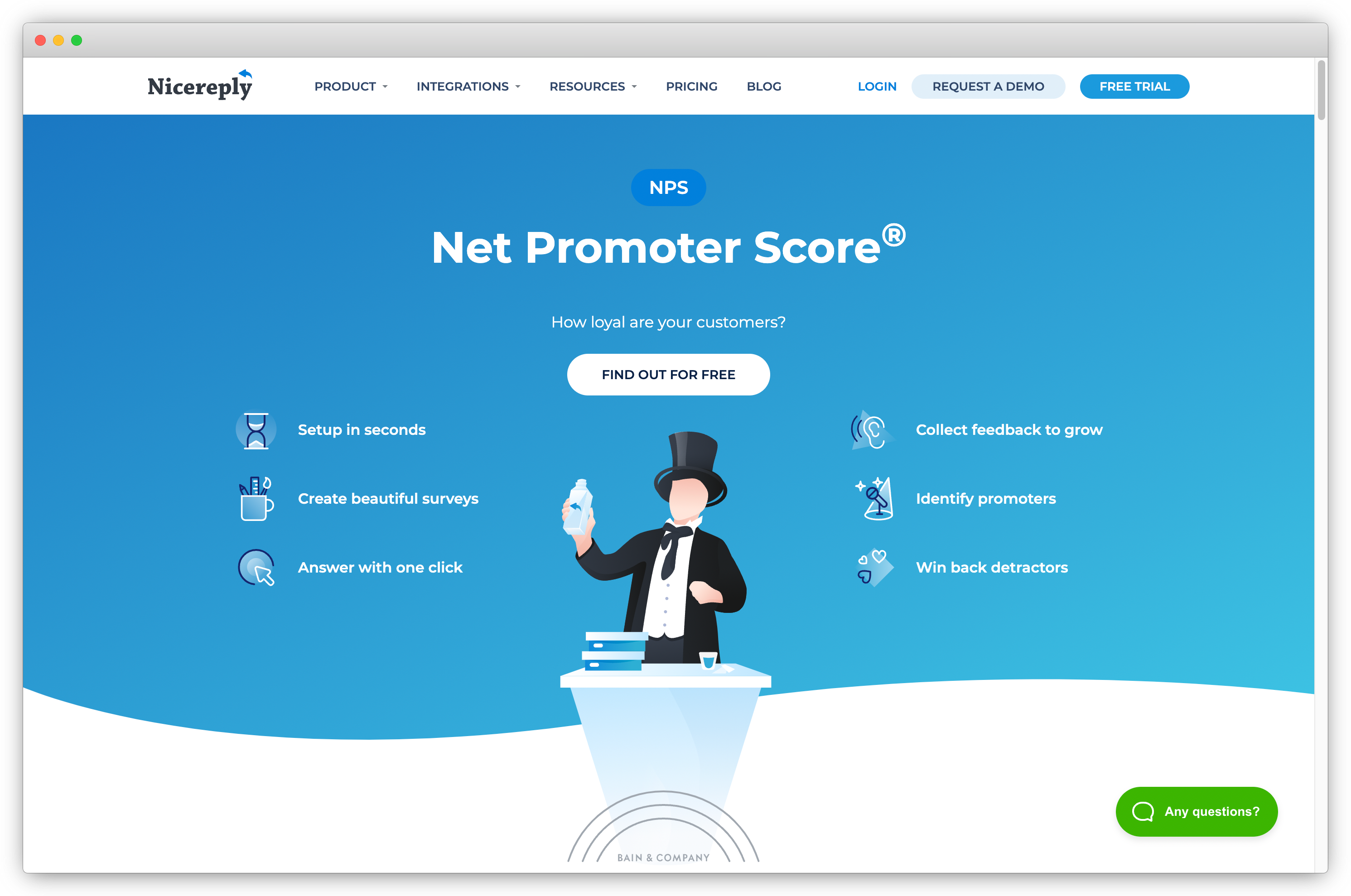
Setup Process
Nicereply offers a seamless integration with leading helpdesk platforms, making the setup process quick and straightforward. It doesn’t have its own sending platform, so businesses can copy and embed survey codes into email signatures, post-ticket emails, or helpdesk workflows. This flexibility allows teams to send surveys directly from their existing tools without needing to manage a separate sending system.
Collection Capabilities
Nicereply focuses on post-interaction feedback collection, enabling support teams to gather immediate insights after customer interactions:
-
Email signature surveys that capture feedback on every agent interaction
-
Post-ticket email surveys sent automatically after support tickets are closed
-
Website Surveys for real-time feedback online
The emphasis is on capturing customer sentiment at the moment of service, making it highly effective for tracking individual agent performance.
AI Features & Reporting
Nicereply offers straightforward reporting focused on feedback trends and agent performance but does not include AI-driven analytics. Key features include:
-
Team and agent performance dashboards to monitor individual and team scores
-
Customer satisfaction trends across CSAT, CES, and NPS metrics
-
Agent leaderboard showcasing top-performing agents based on customer feedback
While reporting is clear and functional, it lacks advanced analytics or AI-driven insights, focusing instead on practical, performance-oriented metrics.
Closing the Feedback Loop
Nicereply offers basic tools for managing customer feedback but doesn’t have extensive features for closing the feedback loop:
-
Immediate alerts for negative feedback, enabling fast follow-ups
-
Manual processes for following up with dissatisfied customers
-
No dedicated workflows or automation for complex follow-ups
The platform keeps the focus on feedback collection and monitoring rather than full-cycle customer issue resolution.
Integrations
Nicereply integrates smoothly with popular helpdesk and support platforms, ensuring feedback collection fits naturally into existing workflows:
-
Zendesk, Freshdesk, and Intercom for embedding surveys in support processes
-
Slack for real-time alerts and team notifications
-
API access for custom integrations and workflows
These integrations help support teams easily capture feedback without disrupting their existing processes.
Pricing
Nicereply offers custom pricing based on team size and usage, making it flexible for businesses of various scales. Pricing starts from $59 per month, and they offer a 14-day free trial.
Ideal for
Nicereply is ideal for customer support teams that want to track agent performance, measure post-interaction satisfaction, and improve overall service quality. It’s particularly effective for businesses focused on CSAT and CES but also supports NPS for teams wanting broader sentiment tracking.
6. GetFeedback: Salesforce Surveys
GetFeedback is a customer feedback platform designed to integrate seamlessly with Salesforce, enabling businesses to collect and analyze customer insights directly within their CRM workflows. By aligning feedback data with sales and support information, teams can act swiftly on customer inputs, enhancing overall experience management. With multi-channel distribution and real-time analytics, GetFeedback streamlines the feedback process for Salesforce-centric organizations.

Setup Process
Setting up GetFeedback is straightforward for Salesforce users, thanks to pre-built templates and managed or custom mappings. The platform allows for quick deployment, enabling businesses to launch feedback programs in minutes. Administrators can connect GetFeedback to multiple Salesforce environments, such as sandbox and production, facilitating testing and seamless integration.
Collection Capabilities
GetFeedback supports multi-channel feedback collection, allowing businesses to reach customers through:
-
Email Surveys: Distribute branded surveys via email to gather customer insights.
-
SMS Surveys: Engage customers on-the-go with mobile-optimized surveys.
-
Web-Based Surveys: Embed surveys on websites or display them as pop-ups to capture visitor feedback.
-
In-App Surveys: Collect feedback directly within mobile applications.
These channels ensure businesses can capture feedback at critical touchpoints throughout the customer journey.
AI Features and Reporting
Within Salesforce, GetFeedback offers customizable dashboards and real-time reporting, enabling teams to monitor key metrics such as NPS, CSAT, and CES. By combining Salesforce operational data with customer experience feedback, businesses can uncover trends and assess how customer sentiment impacts their operations. While the platform excels in integration and real-time data visualization, some users have noted a desire for more advanced reporting features and deeper analytics capabilities.
Closing the Feedback Loop
GetFeedback leverages Salesforce workflows to automate follow-ups and escalations based on survey responses. For instance, negative feedback can trigger immediate alerts to account managers, prompting timely interventions. Tasks can be created within Salesforce to ensure accountability and track resolution progress, facilitating a proactive approach to customer satisfaction.
Integrations
As a native Salesforce application, GetFeedback integrates effortlessly with various Salesforce products, including Sales Cloud, Service Cloud, Marketing Cloud, and Pardot. This integration allows feedback data to enrich customer records, providing a comprehensive view of customer interactions. Additionally, GetFeedback offers integrations with platforms like Slack for real-time notifications and Zapier for connecting with other third-party applications, enhancing its versatility within diverse tech stacks.
Pricing
GetFeedback operates on a tiered pricing model, with plans starting at $50 per month. The pricing structure is designed to accommodate businesses of varying sizes, with custom plans available for organizations requiring advanced features or higher response volumes. While the platform offers robust functionality, some users have expressed concerns regarding the cost, especially when integrating extensively with Salesforce.
Ideal for
GetFeedback is ideal for businesses that heavily utilize Salesforce and seek to integrate customer feedback directly into their CRM workflows. It's particularly beneficial for organizations aiming to align feedback with sales and support data, enabling swift, informed actions to enhance customer experience. Companies looking for a solution that offers seamless Salesforce integration, multi-channel feedback collection, and real-time analytics will find GetFeedback a valuable addition to their customer experience toolkit.
7. Survicate: Digital Businesses
Survicate is a versatile online survey tool tailored for digital-first businesses seeking flexible and lightweight NPS solutions. It offers multiple distribution channels, including web pop-ups, email, in-app, and mobile surveys, enabling companies to engage customers at various touchpoints. With an intuitive drag-and-drop interface and real-time reporting, Survicate empowers startups and digital enterprises to gain actionable insights without the complexity of traditional survey tools.
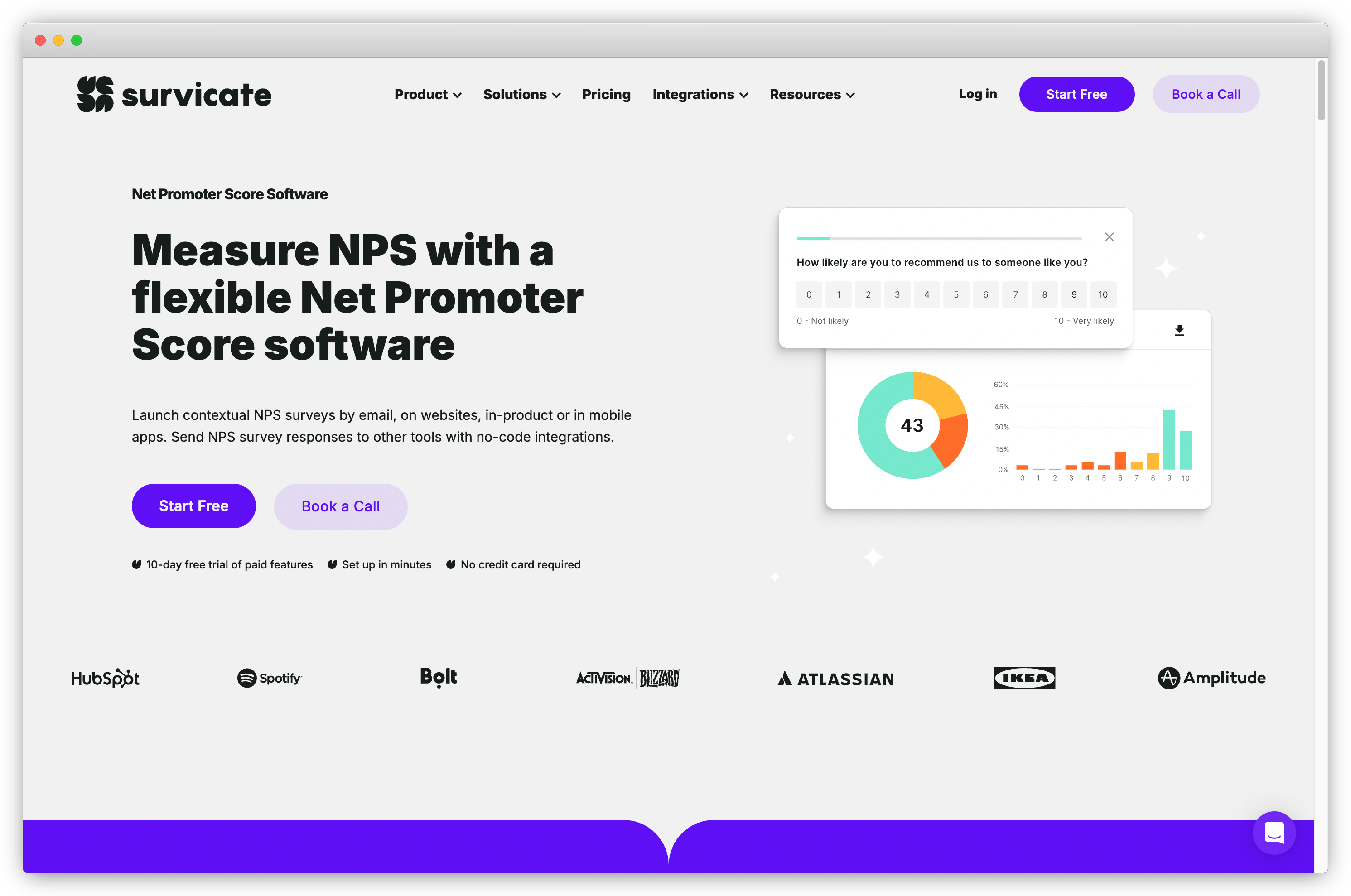
Setup Process
Survicate's user-friendly setup features a drag-and-drop survey builder, allowing businesses to create and deploy surveys swiftly without coding expertise. The platform provides over 125 professional survey templates, facilitating quick customization to align with specific objectives.
Collection Capabilities
Survicate supports a wide array of feedback collection methods:
-
Email Surveys: Embed questions directly into emails to enhance response rates.
-
Web Pop-Ups: Deploy targeted surveys on websites to capture visitor feedback.
-
In-App Surveys: Gather user insights within mobile or web applications.
-
Mobile Surveys: Optimize surveys for mobile devices to reach users on the go.
This multi-channel approach ensures comprehensive coverage across the customer journey.
AI Features and Reporting
Survicate offers real-time dashboards and automated reports, enabling businesses to monitor key metrics such as NPS, CSAT, and CES. The platform includes AI-driven text analysis and themes and subthemes to interpret open-ended responses, providing deeper insights into customer sentiment and emerging trends.
Closing Feedback Loop
While Survicate provides basic workflows for follow-ups and alerts, facilitating prompt responses to customer feedback, it may lack advanced automation features found in more specialized platforms.
Integrations
Survicate seamlessly integrates with numerous tools, enhancing data synchronization and workflow efficiency:
-
HubSpot: Sync survey data with CRM records for enriched customer profiles.
-
Intercom: Trigger surveys based on user behavior and interactions.
-
Mailchimp: Incorporate surveys into email campaigns for targeted feedback collection.
-
Google Analytics: Analyze survey data alongside website metrics for comprehensive insights.
These integrations enable businesses to act on feedback within their existing tech ecosystems.
Pricing
Survicate offers a free plan that includes up to 25 responses per month. Paid plans start at $99 per month, providing access to additional features and higher response limits.
Ideal for
Survicate is ideal for digital-first businesses and SaaS startups seeking flexible NPS surveys with multi-channel distribution and straightforward setup. It's particularly suited for teams aiming to gather actionable customer insights without the need for complex configurations.
8. Refiner: SaaS Surveys
Refiner is a customer feedback solution specifically designed for SaaS companies, focusing on in-app NPS surveys. It enables businesses to trigger surveys based on user behavior, segment responses, and gain insights into user satisfaction. With advanced targeting and customizable survey widgets, Refiner ensures that feedback is collected from the right users at optimal times, aiding product and customer success teams in making data-driven decisions by measuring in-context customer loyalty.

Setup Process
Refiner offers a straightforward setup process with customizable survey templates tailored to digital products. The platform provides a simple SDK integration for in-app NPS surveys, allowing businesses to deploy feedback mechanisms directly within their applications.
Collection Capabilities
Refiner excels in precise targeting and advanced triggers for in-app surveys:
-
In-App Surveys: Collect feedback within the application environment, ensuring responses from active users.
-
Advanced User Targeting: Deploy surveys based on user behavior, traits, or engagement levels to gather relevant insights.
This approach maximizes response rates and ensures feedback is contextually relevant.
AI Features and Reporting
Refiner provides powerful analytics and integration options, allowing teams to act on insights quickly to boost user engagement and improve the overall app experience. There aren't any major AI features introduced in the platform yet.
Closing Feedback Loop
Refiner offers dynamic CTAs for post-survey engagement, facilitating immediate follow-up actions based on user responses. While it provides essential tools for closing the feedback loop, businesses seeking more elaborate workflows may need to integrate with additional platforms.
Integrations
Refiner supports seamless integration with various platforms, enabling efficient data flow and enhanced workflow automation.
Pricing
Refiner offers a 30-day free trial, with the Essentials plan priced at $99 per month for up to 5,000 monthly active users.
Ideal for
Refiner is ideal for SaaS businesses and product teams focused on in-app feedback and user experience. Its advanced targeting and seamless integrations make it a valuable tool for those aiming to enhance user satisfaction and inform product development strategies with NPS Surveys.
9. AskNicely: Workflows and Front-line Surveys
AskNicely is a cloud-based customer feedback tool designed to help businesses capture real-time insights through conversational NPS surveys and measure front-line and employee performance. It enables companies to automate feedback collection on a daily basis or after specific events, providing immediate visibility into customer satisfaction levels. With seamless integration into various CRMs and communication tools, AskNicely empowers front-line teams to take prompt, meaningful actions based on customer feedback as well as enables companies to reward to their employees and teams easily.

Setup Process
Setting up AskNicely involves creating customizable NPS surveys that can be automatically distributed to customers. The platform offers a user-friendly interface, allowing businesses to design surveys that align with their brand and objectives. Integration with existing systems is straightforward, facilitating a smooth onboarding experience.
Collection Capabilities
AskNicely supports feedback collection through multiple channels, ensuring comprehensive coverage:
-
Email Surveys: Distribute surveys via email to reach customers directly.
-
SMS Surveys: Engage customers through text messages for immediate feedback.
-
Web Surveys: Embed surveys on your website to capture visitor insights.
This multi-channel approach enables businesses to gather real-time feedback across various customer touchpoints.
AI Features and Reporting
AskNicely provides real-time, dynamic reporting, with AI powered summaries and insights. The key reports and insights are around team performances and team leaderboards. You can deep dive into which attributes of your team require attention with coach, develop and recognize which helps companies focus on the right business areas for growth.
Closing the Feedback Loop
AskNicely facilitates effective feedback management with features designed to ensure timely follow-ups:
-
Automated Workflows: Set up triggers for immediate responses to customer feedback.
-
Real-Time Notifications: Alert teams instantly when feedback is received, enabling prompt action.
These tools help businesses address customer issues swiftly, fostering improved satisfaction and loyalty.
Integration Available
AskNicely offers seamless integration with a variety of platforms, enhancing workflow efficiency:
-
CRM Systems: Connect with Salesforce, HubSpot, and Microsoft Dynamics to synchronize customer data.
-
Communication Tools: Integrate with Slack and Microsoft Teams for real-time feedback alerts.
-
Customer Support Platforms: Sync with Zendesk and Intercom to align feedback with support tickets.
These integrations ensure that feedback is incorporated into existing systems, promoting a unified approach to customer experience management.
Pricing
AskNicely offers plans starting from $449 per month (billed annually), with pricing varying based on the number of responses and additional features. This structure accommodates businesses of different sizes, allowing them to scale their feedback programs accordingly.
Ideal for
AskNicely is ideal for businesses seeking to empower their front-line teams with real-time customer feedback.
10. Gainsight: Customer Success Platform
Gainsight is a comprehensive customer success platform designed to help businesses reduce churn, drive retention, and foster growth by unifying post-sales customer journeys. It aligns the goals and activities of sales, marketing, support, and product teams, providing a singular view of the customer. With features like health scoring, journey orchestration, and revenue optimization, Gainsight enables companies to proactively manage customer relationships and outcomes.

Setup Process
Implementing Gainsight involves a structured onboarding process to align with existing workflows. The platform offers two main packages:
-
Essentials: Designed for growing businesses and customer success organizations looking to start quickly.
-
Enterprise: Tailored for organizations seeking to leverage the full capabilities of the industry’s leading customer success platform.
Both packages provide essential features and onboarding support to ensure a smooth implementation.
Collection Capabilities
Gainsight enables feedback collection through various channels, including in-app surveys and emails, to monitor customer health and satisfaction. This multi-channel approach ensures comprehensive coverage of customer interactions, allowing businesses to gather insights at critical touchpoints.
AI Features and Reporting
The platform utilizes AI-driven analytics to provide predictive insights and identify at-risk customers, aiding in proactive engagement strategies. Features include:
-
Health Scoring: Combines multiple data sources to create a comprehensive assessment of customer health.
-
Horizon AI Analytics: Offers advanced reporting and dashboards to explore trends and share critical insights.
These tools enable businesses to make data-driven decisions to enhance customer satisfaction and retention.
Closing the Feedback Loop
Gainsight offers automated playbooks and task management features to ensure timely follow-up on customer feedback and issues. The platform's journey orchestration capabilities allow for scaling efficiently by combining human and digital touchpoints, ensuring customers receive the attention they deserve.
Integrations Available
Gainsight integrates seamlessly with CRM systems like Salesforce, allowing for a unified view of customer data and streamlined processes. Additionally, it offers open APIs and webhook support for custom integrations, making it adaptable within various tech stacks.
Pricing
Gainsight provides custom pricing based on business needs. The Essentials package is recommended for growing businesses, while the Enterprise package is suited for organizations looking to fully leverage the platform's capabilities. Interested parties should contact Gainsight directly for a personalized quote.
Ideal for
Gainsight is ideal for medium to large enterprises aiming to proactively manage customer success, reduce churn, and drive growth. It's particularly beneficial for organizations seeking a comprehensive platform that aligns multiple teams around a unified customer view.
11. Pendo: In-App NPS Surveys
Pendo offers a seamless way to collect Net Promoter Score (NPS) surveys directly within applications, helping businesses measure customer sentiment and product satisfaction. By embedding NPS within apps, it enables real-time, high-response-rate feedback collection from engaged users, making it particularly useful for SaaS businesses and product-led teams.
Companies relying heavily on email or website-based NPS surveys may need additional tools for a more holistic approach.

Setup Process
Setting up NPS surveys in Pendo is quick and intuitive, especially for teams already using the platform for product analytics and in-app messaging. The process involves:
- Configuring the survey with custom branding and messaging
- Segmenting users based on behavior, role, or account type
- Setting delivery rules to trigger surveys at the right moment
- Defining recurrence (one-time, periodic, or event-driven surveys)
Although the setup is flexible and user-friendly, customization beyond the built-in templates may require additional developer assistance, particularly for advanced targeting rules.
Collection Capabilities
Pendo focuses on in-app NPS collection, which results in higher response rates compared to traditional survey methods. Key collection methods include:
- In-app surveys: Shown to users as non-intrusive overlays while they interact with the product
- Email fallback: A secondary option for users who miss the in-app survey
- Targeted distribution: Surveys can be delivered based on user behavior, ensuring relevant responses
While in-app collection is highly effective for engaged users, it may not capture feedback from less active users or external stakeholders, requiring businesses to supplement with external survey tools if broader insights are needed.
AI Features and Reporting
Pendo provides clear and actionable NPS insights through real-time reporting and analytics:
- AI-powered sentiment analysis tool that helps categorize open-ended responses
- Trend tracking identifies NPS fluctuations over time
- Segment-based reporting allows businesses to filter responses by user type, subscription level, or geography
Closing the Feedback Loop
Pendo helps businesses act on NPS feedback quickly through automation and integrations:
- In-app messaging allows immediate engagement with promoters and detractors
- Follow-up workflows trigger automated tasks based on survey scores
- Slack and CRM integrations notify teams in real-time when NPS responses are received
Integration Capabilities
Pendo integrates well with sales, marketing, and support tools to ensure NPS data is accessible across teams:
- CRM integration (Salesforce) to connect NPS with customer health scores
- Communication tools (Slack, Microsoft Teams) to send real-time NPS alerts
- Product analytics platforms (Looker, Google Analytics) to correlate NPS with user behavior
Pricing
Pendo offers a free plan with basic NPS capabilities for up to 500 monthly active users (MAUs). Paid plans vary based on MAUs and required features, and full pricing details are available on request. While Pendo's NPS is included in broader product plans, businesses that only need NPS surveys may find more cost-effective options in dedicated survey platforms.
Ideal for
Pendo is ideal for product-led teams, SaaS companies, and customer success teams looking for in-app NPS collection with direct product insights. It’s best suited for businesses that want to link NPS feedback with feature adoption and user behavior rather than just gathering broad customer sentiment.
12. Typeform: Beautiful, Interactive Forms
Typeform is an interactive form-building tool that specializes in creating engaging and user-friendly forms, surveys, and quizzes. Known for its clean, modern design and intuitive user experience, Typeform enables businesses to collect data in a conversational manner, enhancing respondent engagement and completion rates. While it offers beautiful, user-friendly forms, Typeform lacks advanced lead generation features, which may be a consideration for businesses focused on conversion. It is also not a tool designed specifically for NPS Surveys, while creating them and measuring customer loyalty is possible through it. You can consider it as a simple nps tool.
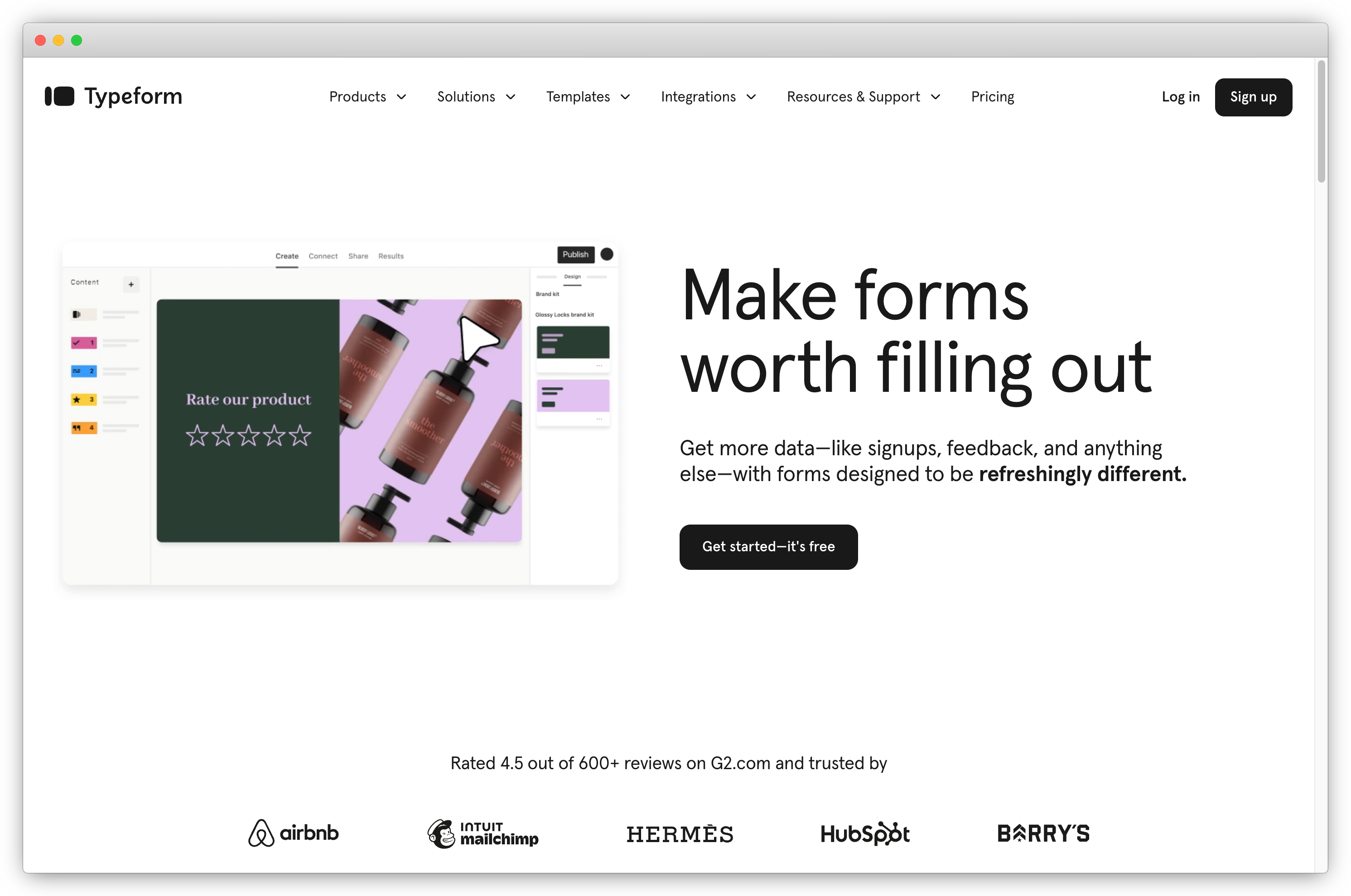
Setup Process
Typeform provides a user-friendly interface with a drag-and-drop builder, allowing users to create nps surveys and modify survey design without any coding expertise. With over 3,000 templates and customizable design options, businesses can quickly deploy forms that align with their brand identity.
Collection Capabilities
Typeform supports multi-channel distribution, enabling businesses to reach respondents through various platforms:
-
Web Embeds: Integrate forms directly into websites.
-
Email: Share forms via email campaigns.
-
Mobile Optimization: Ensure forms are accessible and responsive on mobile devices.
This flexibility allows for effective data collection across different touchpoints.
AI Features and Reporting
While Typeform does not currently incorporate AI-driven analytics, it offers basic reporting to get a good visualization of your scores and responses.
Closing the Feedback Loop
Typeform includes basic features to facilitate follow-up actions:
-
Automated Email Notifications: Receive alerts when new responses are submitted.
-
Integrations with CRM and Email Marketing Tools: Seamlessly transfer data to platforms like HubSpot and Mailchimp for further engagement.
While it provides essential tools for follow-up, businesses seeking more advanced workflows may need to integrate with additional platforms.
Integrations Available
Typeform offers seamless integration with various platforms, enhancing data flow and workflow automation:
-
CRM Systems: Connect with Salesforce and HubSpot to manage leads and customer data.
-
Marketing Tools: Integrate with Mailchimp and Klaviyo for targeted email campaigns.
-
Analytics Platforms: Sync with Google Analytics and Google Tag Manager for in-depth analysis.
These integrations enable businesses to incorporate Typeform into their existing tech stack effectively.
Pricing
Typeform offers a range of pricing options to fit different business needs:
-
Free Plan: Limited to 10 responses per month with basic features.
-
Basic Plan: Starting at $25/month, with up to 100 responses per month and access to essential features.
-
Plus Plan: Starting at $50/month, allowing 1,000 responses and additional customization options.
-
Business Plan: Starting at $83/month, offering 10,000 responses, advanced logic jumps, and priority support.
Custom pricing is also available for enterprise clients with higher response volumes and advanced needs.
Ideal for
Typeform is ideal for small businesses, startups, marketers, and design-focused teams that want to create visually appealing, engaging surveys and forms without complex setups. It’s especially suited for businesses that prioritize user experience and data collection through conversational forms but may not be the best fit for those requiring advanced analytics or lead-generation workflows.
How to Choose the Best NPS Software for Your Business
Selecting the right Net Promoter Score (NPS) tool isn’t just about sending out a 0-10 survey—it’s about choosing a platform that fits your goals, integrates smoothly into your workflow, and helps you turn feedback into action. A great NPS tool doesn’t just collect scores; it empowers you to improve customer loyalty and reduce churn.
So while you know about the top NPS platforms now, how to choose the right NPS tool and get the most from your program. Let's find out.
1. Understand your NPS goals and use cases
Before diving into features, clarify your NPS objectives. Are you focused on transactional NPS (feedback after specific interactions like purchases or support calls) or relationship NPS (periodic surveys to gauge overall sentiment)? Knowing this will help you select a tool that aligns with your needs.
Consider:
-
What insights are you seeking? (Immediate customer satisfaction, long-term loyalty trends, churn risks)
-
Who will use the data? (Customer success, product, marketing, or support teams)
-
What actions will follow? (Closing feedback loops, improving processes, or engaging promoters)
💡 Pro Tip: Don’t limit yourself to one survey type. Combining transactional and relationship NPS provides a complete picture—real-time feedback on specific interactions and broader insights into customer loyalty.
2. Evaluate survey setup and collection capabilities
An effective NPS tool should make creating and distributing surveys easy while maximizing response rates.
Look for:
-
Customizable Surveys: Ability to brand surveys, add logic, and support multiple languages.
-
Multi-Channel Distribution: Email, SMS, in-app, website pop-ups, or kiosks—reach customers where they are.
-
Audience Segmentation: Target specific customer groups based on demographics, behavior, or lifecycle stage.
💡 Pro Tip: Match the channel to the context—email surveys work best for relationship NPS, while in-app or SMS surveys and WhatsApp Surveys are ideal for transactional feedback. This ensures relevance.
3. Leverage AI features & in-depth reporting
A raw NPS score tells you what your customers feel—but not why. That’s where analytics come in.
Besides the basic analysis of quantitative data, look for features like:
-
AI-Powered Sentiment Analysis: Automatically detect themes in open-text responses.
-
Real-Time Dashboards: Track NPS trends, and key insights.
-
Advanced Reporting: Segment data by customer demographics, product usage, or lifecycle stage.
💡 Pro Tip: Use sentiment analysis to dig deeper into open-ended responses. This helps uncover recurring issues and opportunities that scores alone won’t reveal.
4. Focus on Closing the Feedback Loop
Sending NPS Surveys and collecting NPS data is just the start—closing the feedback loop is where real improvements happen. Choose a tool that makes it easy to follow up with everyone - unhappy and satisfied customers.
Key features to look for:
-
Automated Alerts: Notify teams when detractors respond so they can act fast.
-
Follow-Up Workflows: Trigger personalized emails, support tickets, or loyalty offers based on scores.
-
Collaboration Tools: Assign feedback to the right teams and track issue resolution.
💡 Pro Tip: Speed matters—responding to detractors within 24 hours can turn a negative experience into a positive one. It shows customers you’re listening and value their input.
5. Ensure Seamless Integrations
Your Net Promoter Score Software should work hand-in-hand with your existing systems to streamline workflows and enrich customer profiles.
Look for integrations with:
-
CRMs: Like Salesforce, Hubspot or MS Dynamics to centralize customer data.
-
Helpdesks: Such as Zendesk or Freshdesk for post-support surveys.
-
Marketing Tools: Push NPS data into platforms like Mailchimp, ActiveCampaign for targeted campaigns.
💡 Pro Tip: Integrate NPS data into your CRM to build richer customer profiles and tailor communications based on loyalty levels.
6. Compare Pricing & Scalability
NPS tools come with varying pricing structures, so it’s important to find one that fits your budget while supporting future growth.
Consider:
-
Pricing Model: Per user, per survey, or flat-rate plans—choose what aligns with your usage.
-
Included Features: Watch for hidden costs related to integrations, analytics, or user limits.
-
Scalability: Ensure the tool can handle increased survey volume as your business grows.
💡 Pro Tip: Don’t just focus on price—prioritize value. A slightly higher investment in the right tool can lead to better insights, higher responses, and more actionable data.
7. Additional Factors to Consider
Beyond features and pricing, a few extra considerations can make or break your NPS program’s success.
-
Ease of Use: A user-friendly interface ensures quick adoption by teams.
-
Security & Compliance: Look for GDPR and ISO 27001 compliance to protect customer data.
-
Customer Support: Opt for tools with responsive support teams and helpful resources.
-
Trial & Demos: Always test the tool through free trials or demos to ensure it fits your needs.
💡 Pro Tip: Choose a tool that your entire team can use—not just data analysts. Simplicity and usability help ensure your NPS program runs smoothly.
Choosing the right NPS tool goes beyond sending surveys—it’s about creating a system that helps you listen to your customers, understand their needs, and act on their feedback. The best NPS tools empower you to:
-
Collect real-time feedback across multiple touchpoints
-
Analyze customer experience and sentiment deeply
-
Close the feedback loop quickly and effectively
-
Drive customer loyalty and reduce churn
💡 Pro Tip: A well-executed NPS program can do more than measure loyalty—it can transform it. Choose a tool that enables you to not just listen to customers but also act on their feedback and build stronger relationships.
FAQs on Best NPS Tools
1. What is an NPS tool, and why do I need one?
An NPS tool helps businesses collect, analyze, and act on Net Promoter Score (NPS) feedback. It automates NPS survey distribution, tracks customer sentiment in real-time, and integrates with CRMs to streamline follow-ups—making it easier to measure loyalty and improve customer experiences at scale.
2. How do NPS tools support both Transactional and Relationship NPS?
A good NPS tool will allow you to:
-
Automate transactional NPS (post-purchase, after support calls) using triggers.
-
Schedule relationship NPS surveys (quarterly, bi-annually) to assess overall loyalty.
Look for tools that support flexible survey timing and multi-channel delivery (email, SMS, in-app).
3. What features should I look for in an NPS Software?
A good NPS tool should definitely offer all the basic features and more:
-
Customizable Surveys: Brandable templates and logic-based questions to create NPS surveys.
-
Multi-Channel Distribution: Collect customer feedback via Email, SMS, in-app, and web and reach your entire customer base.
-
Real-Time Analytics: Dashboards, sentiment analysis, and trend tracking.
-
Automation: Follow-ups, alerts for detractors, and workflow integration.
-
Integrations: CRM (Salesforce), helpdesk (Zendesk), and marketing tools.
-
Advanced Reporting: NPS segmentation, heatmaps, and benchmarking.
4. How do NPS Software help with follow-up actions?
Effective tools automate follow-ups based on responses:
-
Detractors: Trigger alerts and personalized outreach to resolve issues.
-
Passives: Send targeted offers or content to boost loyalty.
-
Promoters: Encourage reviews, referrals, or upsells.
Some platforms also offer closed-loop feedback management to ensure no response goes unanswered.
5. What’s the best way to distribute NPS surveys using these tools?
Top NPS tools support:
-
Email Surveys: Widely used for relationship NPS.
-
In-App NPS Surveys: Ideal for SaaS and product feedback.
-
SMS Surveys: Great for immediate, post-interaction feedback.
-
Web Pop-ups: Capture visitor sentiment in real-time.
Tip: Choose a tool that allows multi-channel outreach to ensure maximum customers are responding back.
6. How do NPS Software handle analytics and reporting?
They provide:
-
Real-Time Dashboards: Track scores, number of responses and trends.
-
Sentiment Analysis: Identify common themes in open-ended feedback.
-
Segmentation: Analyze responses by demographics, location, or customer lifecycle.
-
Benchmarks: Compare your NPS against industry standards and benchmark performance
7. How do integrations enhance NPS tools?
Integrations connect NPS data with CRMs, helpdesks, and marketing platforms, enabling:
-
Personalized follow-ups based on customer history.
-
Unified customer views for better context.
-
Automated workflows (e.g., opening a support ticket when a detractor responds).
8. Are there best practices for using NPS tools effectively?
-
Keep surveys short and focused.
-
Personalize surveys based on customer segments or journey stages.
-
Automate follow-ups to close the feedback loop quickly.
-
Regularly analyze trends to track loyalty over time.
-
Use integrations to act on feedback in real-time.
9. How do I choose the right NPS Software for my business?
Consider:
-
Ease of Use: Intuitive interface for creating and managing surveys.
-
Customization Options: Flexible branding and question logic.
-
Channel Support: Multiple survey distribution options.
-
Automation & Workflows: For efficient follow-ups and alerts.
-
Integrations Available: Connect with your existing tech stack.
-
Scalability: Can it grow with your business needs and help you in your business growth?
10. How does Zonka Feedback stand out as an NPS tool?
Zonka Feedback is a robust NPS Software with features like:
-
Customizable Surveys: Create customized Net Promoter Score Surveys, tailor questions and branding effortlessly.
-
Multi-Channel NPS Surveys: Email, SMS, web, and in-app to collect customer feedback.
-
Advanced Analytics: Real-time dashboards, sentiment analysis, and heatmaps.
-
Automated Workflows: Triggered follow-ups for detractors and promoters.
-
Seamless Integrations: Connects with CRMs, helpdesks, and marketing tools.










